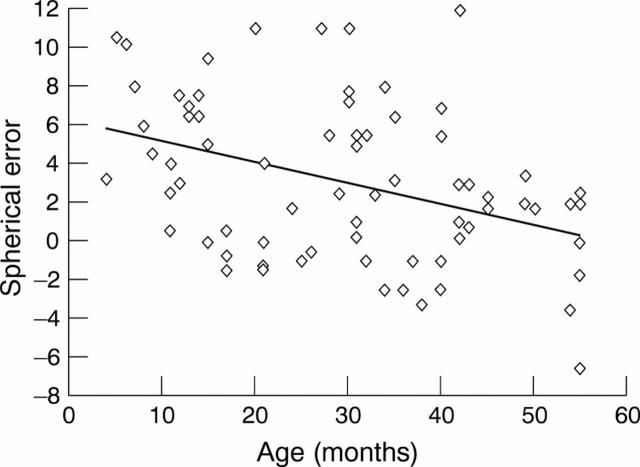Abstract
BACKGROUND—Cataract is the leading cause of blindness in children in east Africa. The results of surgery are poor, partly because of inadequate correction of aphakia. METHODS—A retrospective survey of 118 eyes in 71 children with bilateral cataract. All eyes had implantation of an IOL at the time of cataract surgery. The average age at surgery was 3.5 years. 28 patients(39%) were less than 2 years old at the time of surgery on their first eye. RESULTS—Preoperatively, 75.4% of eyes and 76.1% of patients were blind. A follow up of at least 3 months was available in 91 (77.1%) eyes. In these eyes, 44% had a latest corrected vision of 6/18 or better and 91.2% had a latest corrected vision of 6/60 or better. Eyes with zonular cataract, and eyes operated after the age of 2 years were more likely to obtain a vision of 6/18 or better. 3.3% of eyes and 1.8% of patients had an acuity of less than 3/60. Nystagmus was present in 42.3% of patients before surgery. In those patients followed up for a minimum of 6 months, 10.2% still had nystagmus. The most frequent complication was severe fibrinous uveitis, which occurred in 36 (30.5%) eyes. 62 (52.5%) eyes had a posterior capsulotomy at the time of cataract extraction. Of the remaining 56 eyes, 20 (35.7%) had so far required a posterior capsulotomy. The leading cause of poor visual outcome was amblyopia. Two patients developed severe complications related to the intraocular lens. CONCLUSIONS—Insertion of a lens implant at the time of cataract extraction appears to be well tolerated in the short term, and may offer significant advantages in an African setting.
Full Text
The Full Text of this article is available as a PDF (101.7 KB).
Figure 1 .
Spherical error in 20 eyes followed for 2 years.
Selected References
These references are in PubMed. This may not be the complete list of references from this article.
- Chirambo M. C., Tielsch J. M., West K. P., Jr, Katz J., Tizazu T., Schwab L., Johnson G., Swartwood J., Taylor H. R., Sommer A. Blindness and visual impairment in southern Malawi. Bull World Health Organ. 1986;64(4):567–572. [PMC free article] [PubMed] [Google Scholar]
- Eckstein M., Vijayalakshmi P., Gilbert C., Foster A. Randomised clinical trial of lensectomy versus lens aspiration and primary capsulotomy for children with bilateral cataract in south India. Br J Ophthalmol. 1999 May;83(5):524–529. doi: 10.1136/bjo.83.5.524. [DOI] [PMC free article] [PubMed] [Google Scholar]
- Faal H., Minassian D., Sowa S., Foster A. National survey of blindness and low vision in The Gambia: results. Br J Ophthalmol. 1989 Feb;73(2):82–87. doi: 10.1136/bjo.73.2.82. [DOI] [PMC free article] [PubMed] [Google Scholar]
- Foster A., Gilbert C., Rahi J. Epidemiology of cataract in childhood: a global perspective. J Cataract Refract Surg. 1997;23 (Suppl 1):601–604. doi: 10.1016/s0886-3350(97)80040-5. [DOI] [PubMed] [Google Scholar]
- Foster A., Yorston D. Corneal ulceration in Tanzanian children: relationship between measles and vitamin A deficiency. Trans R Soc Trop Med Hyg. 1992 Jul-Aug;86(4):454–455. doi: 10.1016/0035-9203(92)90268-h. [DOI] [PubMed] [Google Scholar]
- Lloyd I. C., Goss-Sampson M., Jeffrey B. G., Kriss A., Russell-Eggitt I., Taylor D. Neonatal cataract: aetiology, pathogenesis and management. Eye (Lond) 1992;6(Pt 2):184–196. doi: 10.1038/eye.1992.37. [DOI] [PubMed] [Google Scholar]
- Markham R. H., Bloom P. A., Chandna A., Newcomb E. H. Results of intraocular lens implantation in paediatric aphakia. Eye (Lond) 1992;6(Pt 5):493–498. doi: 10.1038/eye.1992.104. [DOI] [PubMed] [Google Scholar]
- Taylor D. The Doyne Lecture. Congenital cataract: the history, the nature and the practice. Eye (Lond) 1998;12(Pt 1):9–36. doi: 10.1038/eye.1998.5. [DOI] [PubMed] [Google Scholar]
- Waddell K. M. Childhood blindness and low vision in Uganda. Eye (Lond) 1998;12(Pt 2):184–192. doi: 10.1038/eye.1998.45. [DOI] [PubMed] [Google Scholar]



